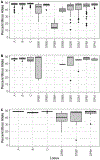Utilizing nanopore sequencing technology for the rapid and comprehensive characterization of eleven HLA loci; addressing the need for deceased donor expedited HLA typing
- PMID: 32595056
- PMCID: PMC7870017
- DOI: 10.1016/j.humimm.2020.06.004
Utilizing nanopore sequencing technology for the rapid and comprehensive characterization of eleven HLA loci; addressing the need for deceased donor expedited HLA typing
Abstract
The comprehensive characterization of human leukocyte antigen (HLA) genomic sequences remains a challenging problem. Despite the significant advantages of next-generation sequencing (NGS) in the field of Immunogenetics, there has yet to be a single solution for unambiguous, accurate, simple, cost-effective, and timely genotyping necessary for all clinical applications. This report demonstrates the benefits of nanopore sequencing introduced by Oxford Nanopore Technologies (ONT) for HLA genotyping. Samples (n = 120) previously characterized at high-resolution three-field (HR-3F) for 11 loci were assessed using ONT sequencing paired to a single-plex PCR protocol (Holotype) and to two multiplex protocols OmniType (Omixon) and NGSgo®-MX6-1 (GenDx). The results demonstrate the potential of nanopore sequencing for delivering accurate HR-3F typing with a simple, rapid, and cost-effective protocol. The protocol is applicable to time-sensitive applications, such as deceased donor typings, enabling better assessments of compatibility and epitope analysis. The technology also allows significantly shorter turnaround time for multiple samples at a lower cost. Overall, the nanopore technology appears to offer a significant advancement over current next-generation sequencing platforms as a single solution for all HLA genotyping needs.
Keywords: HLA genotyping; Human Leukocyte Antigens; NGS; Oxford Nanopore sequencing; Transplantation.
Copyright © 2020 The Authors. Published by Elsevier Inc. All rights reserved.
Conflict of interest statement
Disclosures
D.S. Monos is a consultant to, and owns options in Omixon. D.S. Monos, D. Ferriola and J.L. Duke receive royalties from Omixon. The other authors of this manuscript have no conflicts of interest to disclose.
Figures





References
-
- Lee SJ, Klein J, Haagenson M, Baxter-Lowe LA, Confer DL, Eapen M, Fernandez-Vina M, Flomenberg N, Horowitz M, Hurley CK, Noreen H, Oudshoorn M, Petersdorf E, Setterholm M, Spellman S, Weisdorf D, Williams TM, Anasetti C, High-resolution donor-recipient HLA matching contributes to the success of unrelated donor marrow transplantation, Blood 110 (2007) 4576–4583, 10.1182/blood-2007-06-097386. - DOI - PubMed
-
- Pidala J, Lee SJ, Ahn KW, Spellman S, Wang H-L, Aljurf M, Askar M, Dehn J, Fernandez Vina M, Gratwohl A, Gupta V, Hanna R, Horowitz MM, Hurley CK, Inamoto Y, Kassim AA, Nishihori T, Mueller C, Oudshoorn M, Petersdorf EW, Prasad V, Robinson J, Saber W, Schultz KR, Shaw B, Storek J, Wood WA, Woolfrey AE, Anasetti C, Nonpermissive HLA-DPB1 mismatch increases mortality after myeloablative unrelated allogeneic hematopoietic cell transplantation., Blood. 124 (2014) 2596–2606. 10.1182/blood-2014-05-576041. - DOI - PMC - PubMed
MeSH terms
Substances
Grants and funding
LinkOut - more resources
Full Text Sources
Other Literature Sources
Research Materials

